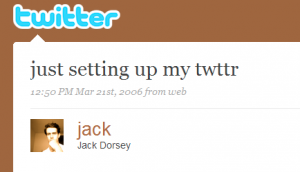 The microblogging platform Twitter turns 5 today, as it was on March 21, 2006, that co-founder Jack Dorsey sent the world's first tweet: "just setting up my twttr." Billions of tweets later, Twitter has changed the way many of us communicate and get information online.
The microblogging platform Twitter turns 5 today, as it was on March 21, 2006, that co-founder Jack Dorsey sent the world's first tweet: "just setting up my twttr." Billions of tweets later, Twitter has changed the way many of us communicate and get information online.
The short, 140-character-or-less messages were once dismissed as recording solely the banalities of life, but Twitter has become an important tool for breaking news and sharing information.
The real-time communication provided by Twitter has had profound implications for education, and while it may not be fully integrated into everyone's academic toolbox yet, it is finding a place there more and more.
So in honor of Twitter's 5th birthday, here's a list of the 5 ways in which Twitter has changed (and probably still can change) education:
- BRINGS THE WORLD INTO THE CLASSROOM: Internet resources like Twitter give students access to information -- more importantly, perhaps -- to people beyond the classroom walls. Students can post inquiries online and receive responses in real- or near real-time, such as this example from Sylvia Tolisano who used Twitter to help identify an animal skeleton that her third-grade students had found on the playground.
- HELPS COMMUNICATION BETWEEN SCHOOL AND HOME: A Twitter account for a school or a teacher can be another means (and a paperless one at that) to communicate information to parents on things like events, school closures, and deadlines.
- GIVES EDUCATORS REAL-TIME PROFESSIONAL DEVELOPMENT: Rather than waiting for school-sanctioned PD events and rather than having to locate experts on their own, Twitter gives educators access to a vast social network of other like-minded professionals. Questions posed to Twitter are often answered quickly, and special hashtags, such as #edchat, provide a forum for where teachers to address specific topics at scheduled times.
- CREATES CUSTOMIZED PROFESSIONAL NETWORK: It isn't just educators that are using Twitter to expand their access to experts. Twitter has become a key tool for creating personal learning networks, enabling anyone to build their own connections with other Twitter users, sharing learning resources and support. This support has been shown in several studies to help boost student achievement.
- CAPTURES CONVERSATIONS: The twitters in the back of the classroom used to be seen as distractions and disruptions. By using Twitter, many educators are finding ways to capture these "backchannel" conversations, harnessing rather than silencing conversations that occur during lectures and presentations by taking instant polls and asking for feedback through Twitter.
Educators, we'd love to hear how you're using Twitter for teaching and learning.

